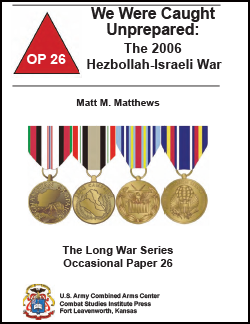
The 2006 Hezbollah-Israeli War
By Matt M. Matthews
105 Pages
Occassional Paper No. 26 - Published: 2008
The Combat Studies Institute (CSI) is pleased to present Long War Series Occasional Paper 26, We Were Caught Unprepared: The 2006 Hezbollah-Israeli War by CSI historian Mr. Matt M. Matthews. The outcome of the war that was, at best, a stalemate for Israel has confounded military analysts throughout the world. Long considered the most professional and powerful army in the Middle East, with a history of impressive military victories against its enemies, the Israeli Defense Forces (IDF) emerged from the campaign with its enemies undefeated and its prestige severely tarnished.
Matthews’s historical analysis of the war includes an examination of IDF and Hezbollah doctrine prior to the war, as well as an overview of the operational and tactical problems encountered by the IDF during the war. His research convincingly argues that the Israeli reliance on poorly understood and controversial Effects-Based Operations (EBO) and Systemic Operational Design (SOD) warfighting theories, and a nearly singular dependence on air power, were root causes of Israeli problems. Additionally, after years of counterinsurgency (COIN) operations in the Gaza Strip and West Bank territories, IDF ground forces were tactically unprepared and untrained to fight against a determined Hezbollah force that conducted what was, in many ways, a conventional, fixed-position defense. In researching this study, Mr. Matthews interviewed several prominent IDF officers and other experts in the field, many of whom had not previously been interviewed. The result is an insightful, comprehensive examination of the war.
In 2006, Hezbollah demonstrated that terrorist groups around the world are capable of learning from, adapting to, and exploiting weaknesses in conventional military forces. Inasmuch as the US Army has focused almost exclusively on irregular warfare since 2001, the lessons offered in this analysis are particularly relevant. We believe that this study will be of great use to the US Army as it conducts current operations and prepares for an uncertain future in which potential enemies are watching and learning. CSI–The Past is Prologue!
Download the PDF 